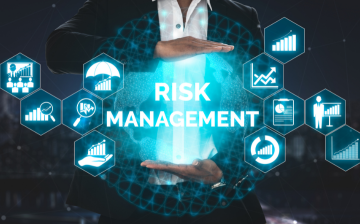
What is Diploma in Risk Management & Why Is It Important?
What is Diploma in Risk Management & Why Is It Important?
Many companies today are facing a multitude of risks across all sectors in an uncertain world: cyber risk, operational risk, financial risk, reputational risk, and regulatory risk. Diploma in Risk management refers to the process of handling risk through identification, assessment, and mitigation, and involves skilled professionals trained in risk strategy. With corporations becoming increasingly sophisticated and connected, this is the best time for individuals with training in risk strategy to thrive.
This blog will help you grasp the basics, applications, and job possibilities of risk management if you’re considering getting a diploma in the field.
Risk Management: What Is It?
Organizations use risk management as a structured process to identify potential risks that could harm their objectives or operations, assess the likelihood or severity of their impact, and implement plans to mitigate or manage those risks.
Risks may arise from the external environment (market changes, cyber-attacks, regulatory changes) or the internal environment (system failures, fraud, or employee issues). However, an effective risk management approach ensures that an organization can:
- Reduce losses and liabilities
- Continue to operate as usual
- Preserve brand value and reputation
- Improve decision-making processes
- Maintain adherence to legal and regulatory obligations
To gain the theoretical knowledge and practical skills necessary to manage risk at an enterprise level, many professionals choose to formally validate their expertise with a risk management diploma.
What Makes Risk Management Crucial?
Stability and Business Continuity
Uncontrolled risks can lead to significant disruptions. It is necessary for organizations to understand the type of impact global pandemics or data breaches can cause and have contingencies in place to maintain stability and ensure continued operations. Good risk management prepares businesses for the unexpected.
Protection of Finances
Risks such as fraud, credit defaults, and currency fluctuations can directly impact a business’s financial results. Effective financial risk management significantly improves an organization’s ability to remain profitable.
Adherence to Regulations
Most industries are governed by laws and regulations. Failure to comply can result in penalties, and in severe cases, even closure. Risk managers help companies reduce their exposure to non-compliance by keeping up with evolving legal requirements.
Managing Reputation
In today’s digital environment, a brand’s reputation can deteriorate within minutes due to poor decision-making, mishandled crises, or ethical oversights. A skilled risk manager can anticipate such scenarios and create prevention and response plans.
Strategic Planning
Risk is a natural component of any business strategy. Incorporating risk intelligence into strategic planning allows companies to take calculated risks that promote innovation and growth.
These strategic aspects are covered in risk management diploma programs, enabling professionals to think long-term and tactically about their industry.
Key Topics Included in a Diploma in Risk Management
Most risk management diploma programs cover a wide range of risk domains, including:
- Market, Credit, and Liquidity Risk
- Operational Risk: Supply chain disruptions, fraud, and internal process failures
- Strategic Risk: M&A, market entry, and business model disruption
- Cybersecurity Risk: Cyber threats and data protection
- Reputational Risk: Stakeholder management and crisis communication
- Regulatory and Compliance Risk: Ethics, governance, and legal adherence
Additionally, some programs integrate technology tools such as Python for risk analytics, Excel modeling, and Power BI.
Career Paths in Risk Management
The demand for skilled professionals is growing as businesses seek stronger risk frameworks. Common job titles include:
- Risk Analyst
- Risk and Compliance Manager
- Internal Auditor
- ESG Risk Consultant
- Cybersecurity Risk Manager
- Enterprise Risk Officer
A risk-management diploma opens doors across industries such as banking, insurance, manufacturing, consulting, healthcare, and information technology.
Highlight on GRMI: Risk Education’s Future
The Global Risk Management Institute (GRMI) has emerged as a leading institution in hands-on, industry-relevant risk education.
Its flagship Post Graduate Diploma in Risk Management (PGDRM) is widely considered one of India’s most comprehensive risk programs. Developed in collaboration with risk professionals from top firms like EY, Deloitte, and KPMG, the PGDRM is ideal for learners seeking more than theory and aiming for practical mastery of risk frameworks.
Why Opt for GRMI?
- Duration: Intensive full-time program of one year
- Curriculum: Covers more than 40 risk domains
- Faculty: Taught by industry professionals and global experts
- Tech Integration: Includes predictive modeling, automation, and BI tools
- Career Outcomes: Strong placement assistance across corporates, consultancies, and Big Four firms
GRMI’s PGDRM is a game-changer for those seeking a risk management diploma that promises both short-term ROI and long-term career advancement.
How to Pick the Best Program for Risk Management
If you plan to pursue a risk management diploma, consider the following:
- Accreditation: Ensure the program is recognized by academic and industry bodies
- Curriculum Breadth: Choose programs covering multiple types of risks
- Faculty Expertise: Industry-taught courses bring real-world insights
- Placement Record: Strong connections with companies improve job outcomes
- Alumni Network: Useful for mentorship, networking, and career support
Applications of Risk Management in the Real World
Example 1: Banking Industry
Risk managers in banks monitor credit exposure, ensure regulatory compliance, develop strategies for managing market volatility, and evaluate borrower reliability.
Example 2: Healthcare Sector
In healthcare, risk specialists assess vendor reliability, ensure data privacy compliance (e.g., HIPAA), and implement patient safety protocols to maintain trust and functionality.
Example 3: Manufacturing
Risk professionals use predictive maintenance, supplier diversification, and contingency planning to manage operational risks like supply chain disruptions or equipment failures.
These examples show the crucial role that certified risk professionals play in ensuring business continuity and resilience.
Upcoming Developments in Risk Management
- Automation & AI: Early identification of risks through predictive modeling
- Cybersecurity: Increasing need for upskilling to combat advanced threats
- Climate & ESG Risks: Growing importance of sustainability in risk profiles
- Global Integration: A need for a global perspective due to cross-border regulations
Conclusion
Risk management has evolved from a back-office support function to a strategic pillar in modern business.
The skills gained through a risk management diploma empower professionals to manage uncertainty, drive growth, and protect long-term value—regardless of their prior experience level.
By providing industry-integrated programs that close the gap between classroom instruction and practical application, organisations such as GRMI are setting the standard and preparing graduates for the workforce right away.
You may also like

How to Select the Right Risk Management Institute for Your Career



